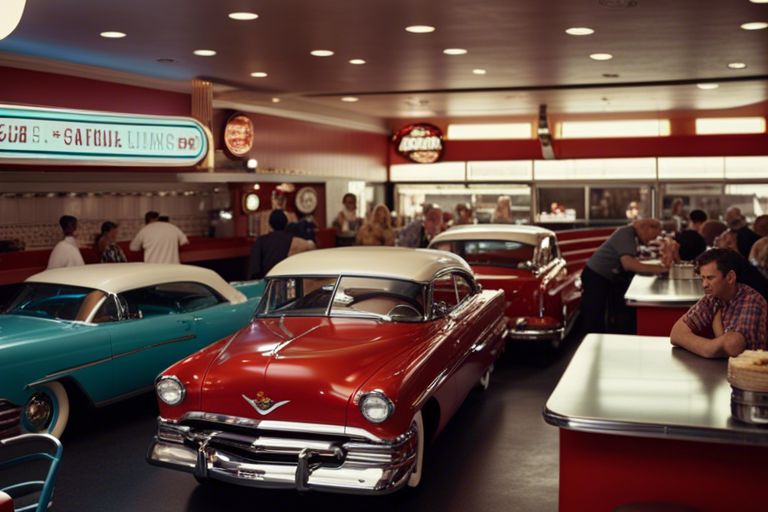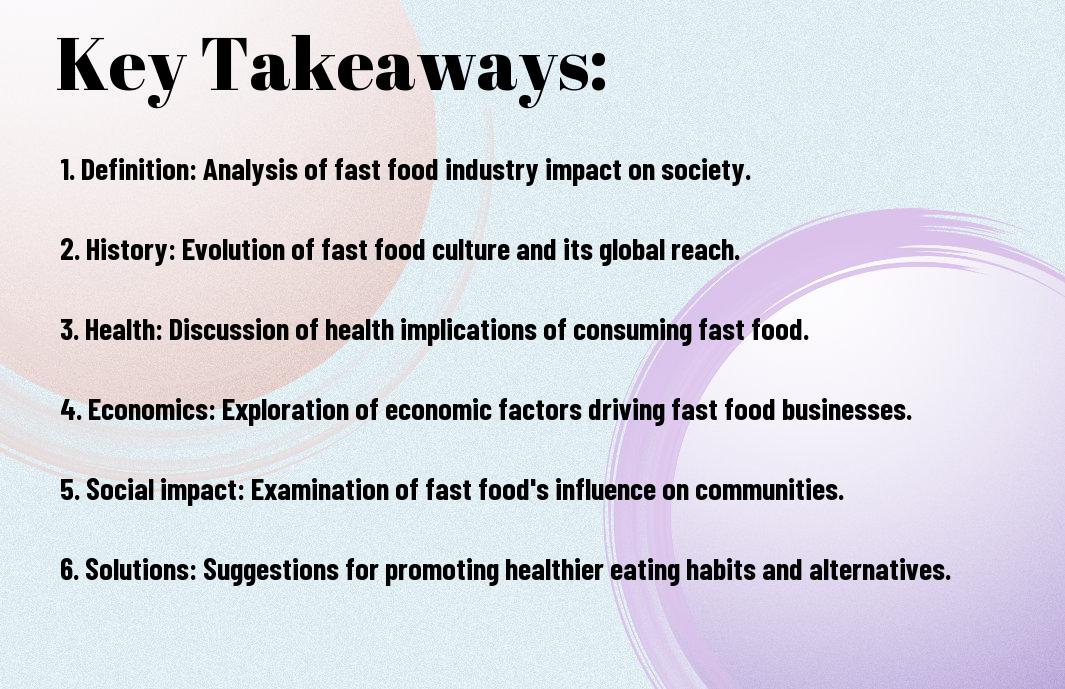With the hustle and bustle of daily life, grabbing a quick bite from a fast food joint may seem like the easiest option. However, not all fast food has to be unhealthy. By making mindful choices, you can still enjoy a convenient meal that is nutritious and good for you. In this article, we will explore what qualities make a fast food option a healthier choice and provide you with tips on how to make better decisions when you’re on the go.
Key Takeaways:
- Ingredients: Healthy fast food should be made with fresh, whole ingredients like vegetables, fruits, lean proteins, and whole grains.
- Preparation: The preparation method is important in determining the healthiness of fast food. Grilled or baked options are better choices than fried foods.
- Portion Control: Pay attention to portion sizes when choosing healthy fast food options. Opt for smaller-sized meals or share larger portions to avoid overeating.
Defining Healthy Fast Food
Nutritional Guidelines
Fast food doesn’t have to be synonymous with unhealthy choices. When looking for healthy options, make sure to check the nutritional guidelines. Choose items that are lower in saturated fats, trans fats, added sugars, and sodium. Opt for menu items that are high in fiber, protein, vitamins, and minerals to support your overall health.
Debunking Common Myths
Common misconceptions about fast food often lead us to believe that all fast food is unhealthy. This is not always the case. Many fast-food chains now offer healthier alternatives, including salads, grilled proteins, and fresh fruit options. It’s important to remember that you can make smart choices even when eating on the go.
It’s a misconception that fast food is always high in calories. In reality, many fast food restaurants now offer calorie-controlled options that can fit into a balanced diet. By paying attention to portion sizes and choosing wisely, you can enjoy a quick meal without sacrificing your health goals.

The Rise of Healthy Fast Food Chains
Some fast-food chains are adapting to meet the growing demand for healthier options. Market trends and consumer demand are pushing traditional fast-food giants to include more nutritious choices on their menus. The rise of health-conscious consumers has led to a shift in the industry, with a surge in the popularity of healthier fast-food alternatives.
Market Trends and Consumer Demand
On one hand, consumers today are more informed about the impact of their food choices on their health. As a result, they are seeking out options that are made with fresh ingredients, less processed food, and lower in unhealthy fats and sugars. This has prompted fast-food chains to revamp their menus to cater to these changing preferences and provide healthier alternatives.
Successful Business Models
With the success of niche players like salad-focused chains and restaurants offering customizable, nutritious bowls, traditional fast-food companies are also adopting similar strategies. They are integrating technology to streamline ordering processes, offering online nutritional information, and partnering with suppliers to source high-quality ingredients. These changes are aimed at appealing to health-conscious consumers while still maintaining the speed and convenience that fast food is known for.
Demand for healthy fast food is on the rise, driven by an increasing awareness of the importance of eating well-balanced meals even on the go. By offering menus that prioritize fresh, wholesome ingredients and transparent preparation methods, fast-food chains are tapping into a lucrative market that values both convenience and nutritional value.
Key Ingredients for Healthy Fast Food
Many sources such as Healthy Fast Food Options: Find the Healthiest Fast Food emphasize the importance of choosing the right ingredients to make fast food healthier. By incorporating whole foods and plant-based options, along with lean protein sources, you can enjoy fast food that is both tasty and nutritious.
Whole Foods vs. Processed Foods
To make healthier fast food choices, opt for whole foods over processed foods whenever possible. Whole foods are in their natural state and provide vital nutrients like vitamins, minerals, and fiber that are often lacking in processed foods. Whole foods include fruits, vegetables, whole grains, nuts, seeds, and lean proteins. Processed foods, on the other hand, are often high in unhealthy fats, sugars, and additives that can negatively impact your health.
Plant-Based Options
Foods derived from plants, such as fruits, vegetables, legumes, nuts, and seeds, offer a wide range of nutrients and health benefits. Plant-based options are rich in fiber, vitamins, minerals, and antioxidants, making them excellent choices for healthy fast food. By incorporating more plant-based foods into your diet, you can improve your overall health and reduce your risk of chronic diseases like heart disease, diabetes, and obesity.
Plant-based options can include veggie burgers, tofu stir-fries, lentil salads, or grain bowls filled with a variety of colorful vegetables and flavorful toppings. These options are not only delicious but also satisfying and nutrient-dense, making them a great choice for healthy fast food.
Lean Protein Sources
Fast food doesn’t have to be synonymous with greasy burgers and fried chicken. Choosing lean protein sources like grilled chicken, turkey, fish, tofu, or legumes can help you create healthier fast food options. Lean proteins are vital for building and repairing tissues, supporting immune function, and promoting satiety, making them an important component of a balanced diet.
Sources of lean protein can be incorporated into salads, wraps, bowls, or sandwiches for a satisfying and nutritious meal. By choosing lean proteins instead of high-fat options, you can significantly reduce the calorie and fat content of your fast food while still enjoying delicious flavors and textures.

Healthy Fast Food Options
Salads and Bowls
All fast-food restaurants offer salads and bowls that can be a healthy option for you. These dishes are usually loaded with fresh vegetables, lean protein, and a variety of delicious toppings. Opt for a salad with grilled chicken or tofu, and choose vinaigrette dressing on the side to control the amount of added calories.
Grilled Chicken and Fish
On the menu, you’ll find grilled chicken and fish options that are lower in fat and calories compared to fried items. Grilled proteins are a great source of lean protein and can be paired with a side of steamed veggies or a small salad for a well-balanced meal.
Veggie Burgers and Sandwiches
Options like veggie burgers and sandwiches can be a nutritious alternative to traditional fast-food burgers. These plant-based options are usually packed with fiber and vitamins, making them a satisfying choice for your meal. Look for whole grain buns and load up on extra veggies for added nutrition.
Nutrition Labeling and Transparency
Reading Labels Like a Pro
Nutrition labeling on fast food packaging can be overwhelming, but it is crucial for making informed choices about what you eat. When scanning a nutrition label, focus on key components like serving size, calories, saturated fats, sodium, and added sugars. Note, the ingredients are listed by quantity, so the first few ingredients are the most prominent in the product. Be wary of long lists of ingredients that are hard to pronounce or understand.
Hidden Ingredients to Watch Out For
One thing to be cautious of is hidden ingredients in fast food items. These can include artificial trans fats, high fructose corn syrup, and excessive sodium levels. Artificial trans fats can increase bad cholesterol levels and lower good cholesterol in the body, leading to a higher risk of heart disease. High fructose corn syrup, a common sweetener in fast food, has been linked to obesity and diabetes. Excessive sodium intake is also a concern, as it can contribute to high blood pressure and other health issues.
Labeling on fast food products can sometimes be misleading, with terms like ‘low-fat’ or ‘natural’ giving a false sense of healthiness. It’s important to read the entire nutrition label and not just the front of the package to understand the true nutritional content of the food you are consuming. Note, the more transparent a company is about its ingredients and nutritional values, the better it is for you to make an informed choice about what you eat.
Cooking Methods Matter
Grilling vs. Frying
After selecting a healthy fast food option, the cooking method used can greatly impact its nutritional value. Concerning grilling versus frying, grilling is generally a healthier option. Grilling allows excess fats to drip off the food, resulting in a lower overall fat content. Additionally, grilling helps retain more nutrients in the food compared to frying, where the high heat and oil can lead to nutrient loss.
Steaming and Roasting
For a healthier fast food choice, consider dishes that are steamed or roasted. Steaming involves cooking food over boiling water, which helps retain most of the food’s nutrients while keeping the calorie content low. Roasting, on the other hand, uses dry heat in an oven to cook the food, enhancing its natural flavors without the need for excessive oils or fats.
This cooking method is especially beneficial for vegetables, as steaming and roasting can help preserve their vitamins and minerals, making them a nutritious addition to your fast food meal.

Conclusion
With these considerations in mind, you can now make more informed choices when it comes to selecting healthy options at fast food restaurants. Remember to prioritize whole, unprocessed foods, opt for grilled or baked items over fried, and be cautious of hidden sugars and excessive fats. By being mindful of your choices and making small adjustments, you can enjoy a convenient meal without compromising your health.
Next time you find yourself in need of a quick meal on the go, take a moment to consider your options and choose wisely. With a little awareness and some simple guidelines, you can navigate the world of fast food in a way that benefits your well-being and keeps you feeling energized and nourished.
Q: Is it possible to find healthy options at fast food restaurants?
A: Yes, it is possible to find healthy options at fast food restaurants. Many fast food chains now offer menu items that are lower in calories, fat, and sodium, such as salads, grilled chicken sandwiches, and fruit cups.
Q: How can I make healthier choices when dining at a fast food restaurant?
A: To make healthier choices at a fast food restaurant, look for menu items that are grilled or baked instead of fried, opt for water or unsweetened beverages instead of sugary drinks, and choose side dishes like a side salad or fruit cup instead of fries. You can also ask for dressings and sauces on the side to control portion sizes.
Q: Are there any fast food chains that specialize in healthy options?
A: Yes, there are fast food chains that specialize in offering healthier menu options. Some examples include Subway, which offers a variety of fresh sandwiches and salads, and Chipotle, where you can customize your meal with fresh ingredients like lean proteins, vegetables, and whole grains.


























